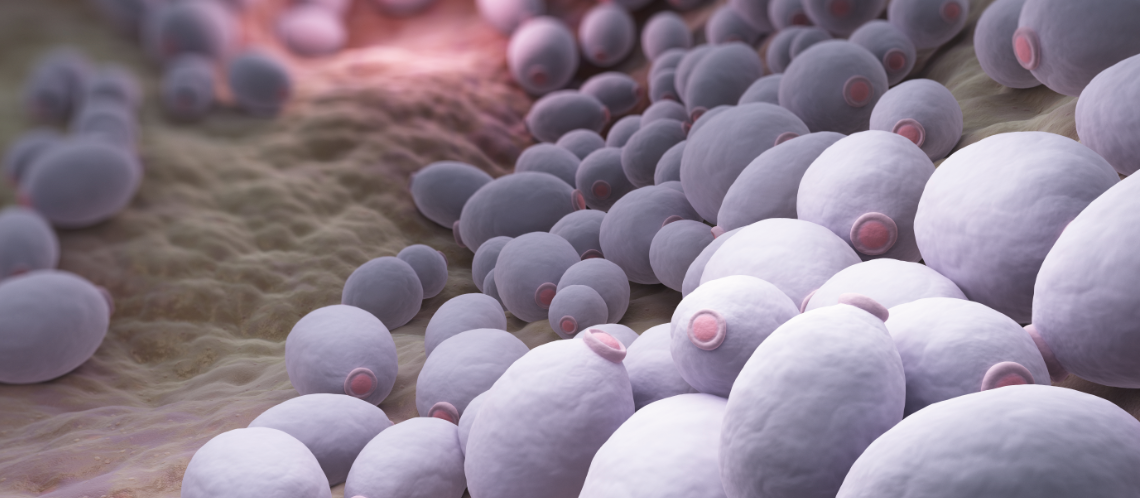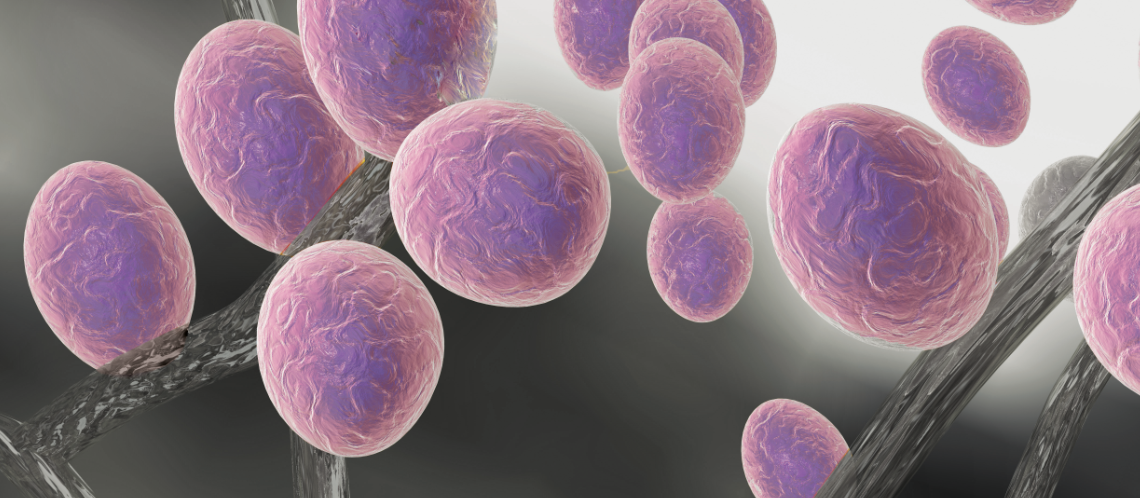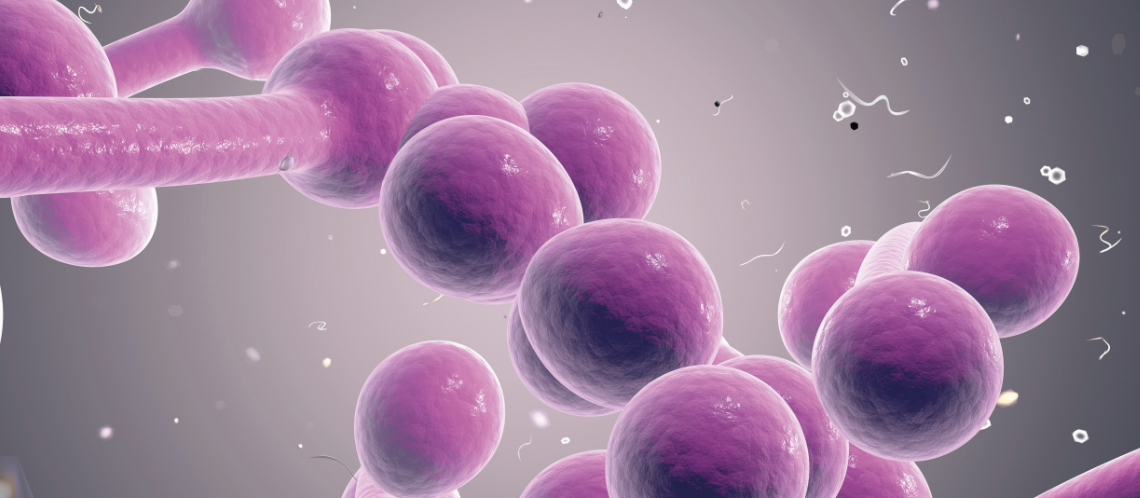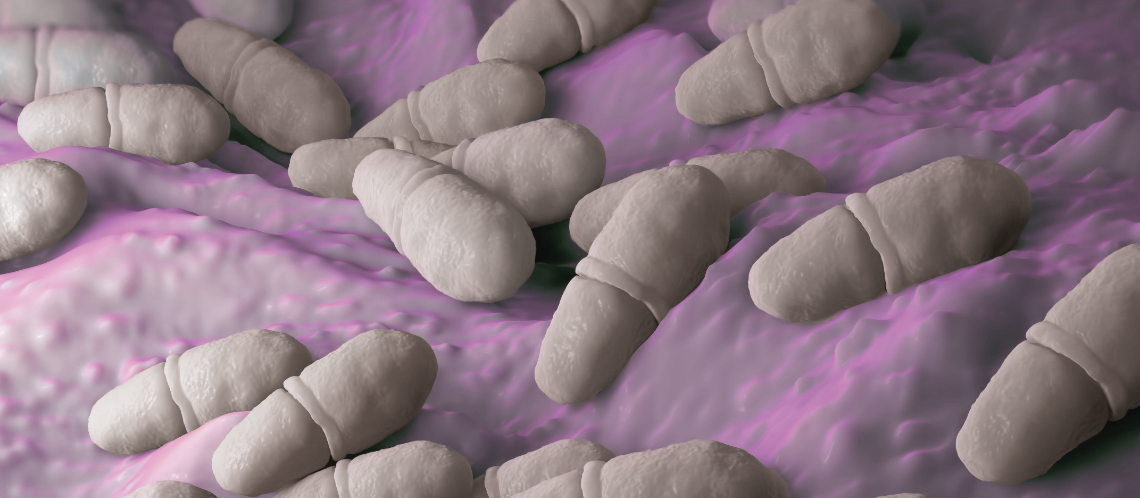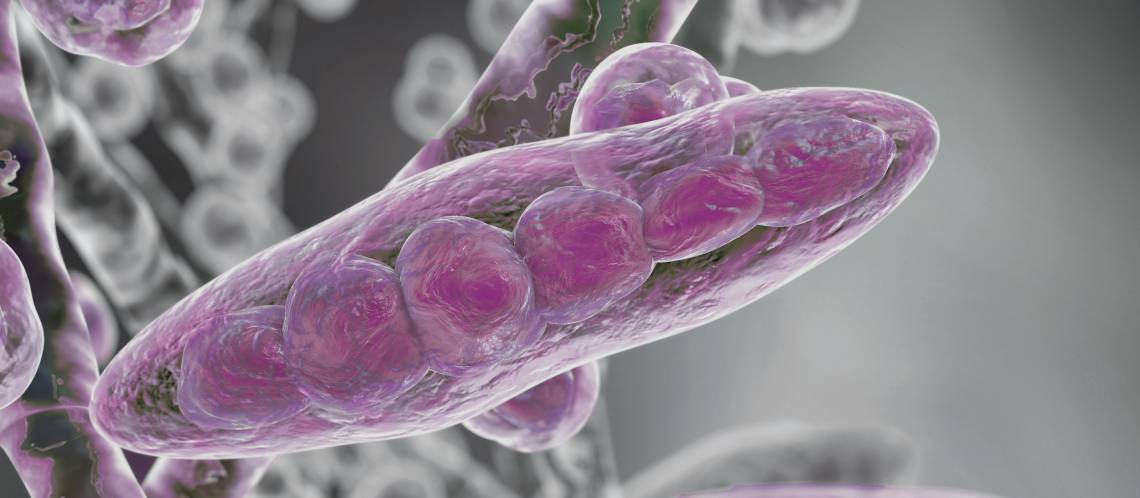Information on dermatomycosis pathogens
This section contains the most important information on the different pathogens which cause fungal infections of the skin, hair and nails and which can be detected using the EUROArray Dermatomycosis.
Anthropophilic dermatophytes
Trichophyton rubrum
Occurrence: Worldwide occurrence. Anthropophilic dermatophyte which colonises human keratinised tissue. Most frequent pathogen causing tinea pedis or tinea ungium. Can also cause infections on other body parts, e.g. tinea corporis or tinea inguinalis in the groin area.
Transmission: Human-to-human transmission by direct or indirect contact (e.g. in swimming pool, sauna or gym).
Trichophyton tonsurans
Occurrence: Worldwide occurrence. Anthropophilic dermatophyte which colonises human keratinised tissue. Mainly spread in the USA and Latin America. Most frequent pathogen causing hair mycosis mainly on the head (tinea capitis) or on the beard (tinea barbae), can also cause infections of the skin and the nails. Also known as wrestler fungus since it is still widely spread amongst these athletes and can lead to infections on different body parts (tinea corporis gladiatorum). In rare cases, the pathogen can also case infection of the nails (tinea unguium).
Transmission: Human-to-human transmission by direct or indirect contact (e.g. via gym mats, hats or combs)
Trichophyton interdigitale
Occurrence: Worldwide occurrence. Anthropohilic dermatophyte which colonises human keratinised tissue. Causes mainly infections of the foot (tinea pedis) and nails (tinea unguium), but may also cause infections on other body parts (tinea corporis).
Transmission: Human-to-human transmission by direct or indirect contact (e.g. swimming pool, sauna or gym).
Trichophyton schoenleinii
Occurrence: Worldwide occurrence. Anthropophilic dermatophyte which colonises human keratinised tissue. Especially spread in Eurasia and North Africa. T. schoenleinii causes mycoses of the scalp (tinea capitis) or beard (tinea barbae) and is especially known for a distinct form of tinea capitis, the tinea capitis favosa (favus). This is characterised by yellowish, circular, cup-shaped crusts (scutula) grouped in patches, in parts with a hair projecting in the centre, on the scalp. Very rarely, T. schoenleinii can also cause fungal infections of the nails.
Transmission: Human-to-human transmission by direct or indirect contact (e.g. via hats or combs).
Trichophyton concentricum
Occurrence: Mainly in South East Asia and South America. Anthropophilic dermatophyte which colonises human keratinised tissue. In affected patients, its mainly causes characteristic, circular and lichen-like scaling skin areas (tinea imbricata).
Transmission: Human-to-human transmission by direct or indirect contact.
Trichophyton violaceum
Occurrence: North, Central Africa, Southern Europe, Asia, and recently also increasingly in Western Europe. Anthropophilic dermatophyte which colonises human keratinised tissue. Frequent causative agent of mycoses of the scalp (tinea capitis), especially in children. Infections on other body parts (tinea corporis) can also occur, in very rare cases, the nails are affected (tinea unguium).
Transmission: Human-to-human transmission by direct or indirect contact (e.g. via hats or combs).
Trichophyton soudanense
Occurrence: Mainly in Africa. Anthropophilic dermatophyte which colonises human keratinised tissue. Mainly causes mycoses of the scalp (tinea capitis), but can also cause infections of the body and the extremities (tinea corporis), the hands (tinea manuum), the feet (tinea pedis) or the nails (tinea unguium).
Transmission: Human-to-human transmission by direct or indirect contact.
Epidermophyton floccosum
Occurrence: Worldwide occurrence. Anthropophilic dermatophyte which colonises human keratinised tissue. Usually affects skin or nails, but not hair. In Europe, it is one of the most common pathogens causing fungal infections of the feet (tinea pedis) and nails (tinea unguium).
Transmission: Human-to-human transmission by direct or indirect contact (e.g. in swimming pool, sauna or gym).
Microsporum ferrugineum
Occurrence: Worldwide. Anthropophilic dermatophyte which colonises human keratinised tissue. Especially spread in Asia, more seldom in Africa or Eastern Europe. Mainly causes mycoses of the scalp (tinea capitis) or beard (tinea barbae), and in rarer cases of the skin and the nails.
Transmission: Human-to-human transmission by direct or indirect contact.
Microsporum audouinii
Occurrence: M. audouinii is an anthropophilic dermatophtye which is especially highly contagious for children. Up until the middle of the 20th century, this pathogen caused epidemics in schools and orphanages. The pathogen is mainly spread in Africa and causes infections of the scalp (tinea capitis) or other body parts (tinea corporis). Owing to increased migration and long distance travel, there are nowadays again more cases of infections with M. audouinii in Central Europe, leading in some cases to small epidemics in kindergardens and schools.
Transmission: Human-to-human transmission by direct or indirect contact.
Zoophilic dermatophytes
Trichophyton eriotrephon
Occurrence: A very rare zoophilic dermatophyte which colonises keratinised tissue of animals. Transmission to humans is also possible, however, only isolated cases of infection with this pathogen have been described.
Transmission: From animals to humans, possibly by direct contact.
Trichophyton equinum
Occurrence: Zoophilic dermatophyte which primarily colonises equine keratinised tissue, but can also be transferred to humans. In humans, the pathogen can cause mycoses on the body (tinea corporis) and head (tinea capitis).
Transmission: From horses to humans by direct contact.
Trichophyton mentagrophytes (formerly: T. interdigitale)
Occurrence: Zoophilic dermatophyte which mainly colonises keratinised tissue of rodents (e.g. guinea pig or rabbits), but can also be transferred to humans. In humans, the pathogen affects the head (tinea capitis) or beard (tinea barbae) and the skin on the trunk, the extremities, or the face (tinea corporis, tinea faciei). This often leads to highly inflammatory, deeply abscessing forms of tinea. In recent years, infections in the genital area (tinea genitalis) with the often terbinafine-resistant T. mentagrophytes types VII and VIII (T. indotineae) have been increasingly observed, which have so far occurred particularly in Thailand and India.
Transmission: From rodents to humans by direct contact.
Trichophyton simii
Occurrence: Zoophilic dermatophyte and emerging pathogen which mainly colonises keratinised tissue of hedgehogs, but can also be transmitted to humans. In humans, the pathogen affects the skin on the trunk and extremities (tinea corporis), the hands (tinea manuum) or the face (tinea faciei).
Transmission: The pathogen can be transmitted from the four-toed hedgehog, Central European hedgehog or Egyptian long-eared hedgehog to humans by direct contact.
Trichophyton quinckeanum (formerly: T. mentagrophytes)
Occurrence: Zoophilic dermatophyte which primarily colonises keratinised tissue of small rodents (e.g. mice, pathogen causing mice favus) or camels, but can also be transmitted to humans. Infections with T. quinckeanum in most cases lead to scutulum-like scaling of the smooth skin (tinea corporis); the scalp is less often affected. As is the case with all infections with zoophilic dermatophytes, inflammatory courses present frequently.
Transmission: From rodents which pass the pathogen on to other animals such as cats, dogs or horses, or from camels to humans by direct contact.
Trichophyton erinacei
Occurrence: Zoophilic dermatophyte and emerging pathogen which mainly colonises keratinised tissue of hedgehogs, but can also be transmitted to humans. In humans, the pathogen affects the skin on the trunk and extremities (tinea corporis), the hands (tinea manuum) or the face (tinea faciei).
Transmission: The pathogen can be transmitted from the four-toed hedgehog, Central European hedgehog or Egyptian long-eared hedgehog to humans by direct contact.
Trichophyton bullosum
Occurrence: Zoophilic dermatophyte which primarily colonises equine keratinised tissue, but can also be transmitted to humans. In humans, it can cause infections of the skin on the trunk and extremities (tinea corporis).
Transmission: From horses to humans by direct contact.
Trichophyton benhamiae (formerly: A. benhamiae)
Occurrence: Worldwide. Zoophilic dermatophyte which affects mainly rodents (primarily guinea pigs), but can also be transmitted to humans. Especially in children and adolescents the pathogen causes inflammatory infections of the scalp (tinea capitis). Also the skin on the trunk and extremities (tinea corporis), the hands (tinea manuum) or the face (tinea faciei) can be affected.
Transmission: From rodents, e.g. guinea pigs, to humans, by direct contact.
Trichophyton verrucosum
Occurrence: Zoophilic dermatophyte which primarily colonises keratinised tissue of young cattle, but can also be transmitted to other animals and humans. The pathogen mainly affects persons who work in agriculture and have contact with diseased animals. In humans, the pathogen causes inflammatory infections which deeply enter the skin, mainly in the area of the scalp (tinea capitis), the face (tinea faciei), the beard (tinea barbae), the extremities (tinea corporis) or the nails (tine unguium).
Transmission: Mainly from cattle to humans by direct or indirect contact.
Microsporum canis
Occurrence: Zoophilic dermatophyte which primarily colonises keratinised tissue of cats and dogs, but can also be transmitted to other animals and also humans. The source of infection is mainly stray dogs or cats in tourist regions. In humans, the pathogen can cause infections of the skin and hair on the head (tinea capitis) or the skin on the trunk or extremities (tinea corporis).
Transmission: Mainly from cats and dogs to humans, by direct contact.
Nannizzia persicolor (formerly: M. persicolor)
Occurrence: Zoophilic dermatophyte which primarily colonises keratinised tissue of rodents (e.g. guinea pigs) and can be transmitted to humans. In humans, the pathogen usually causes severe inflammation of the skin on the trunk and extremities (tinea corporis), the hands (tinea manuum), the feet (tinea pedis) or in the area of the scalp (tinea capitis).
Transmission: From rodents to humans by direct contact.
Geophilic dermatophytes
Nannizzia fulva (formerly: M. fulvum)
Occurrence: Worldwide occurrence. Geophilic dermatophyte which primarily occurs in the soil, but can be transmitted to humans or animals. In humans, the pathogen can cause infections of the scalp (tinea corporis) or the nails (tinea unguium).
Transmission: From soil to humans by direct contact.
Nannizzia gypsea (formerly: M. gypseum)
Occurrence: Worldwide. Geophilic dermatophyte which primarily occurs in the soil, but can be transmitted to humans or animals. Inflammatory infections often occur following contact of the pathogen with a person’s hand, e.g. during gardening and handling soil (tinea manuum). However, other body parts can also be affected (tinea corporis, tinea capitis), as well as the nails (tinea unguium).
Transmission: From soil to humans, by direct contact.
Nannizzia incurvata (formerly: M. incurvatum)
Occurrence: Geophilic dermatophyte which primarily occurs in the soil, and is in some cases transmitted to humans or animals. In humans, the pathogen can cause infections of skin and hair on different parts of the body.
Transmission: From soil to humans by direct contact.
Yeasts
Candida parapsilosis
Occurrence: Worldwide occurrence, also as an airborne germ. Facultatively pathogenic yeast which occurs in most humans as a non-pathogenic organism, but can cause wound and tissue infections and skin or nail infections in immunosuppressed individuals.
Transmission: Most persons carry this pathogen, so that an infection may occur in the case of immunosuppression and presence of an injury which serves as entry site for the pathogen. No further contact with the pathogen is required
Candida albicans
Occurrence: Worldwide occurrence, also as an airborne germ. Facultatively pathogenic yeast which occurs in most humans as a non-pathogenic organism, but can cause infections, e.g. between fingers or toes or on the nails, especially in patients with suppressed or reduced immunity.
Transmission: Most persons carry this pathogen, so that infections may occur with weakened immune system without even requiring further contact with the pathogen.
Candida guilliermondii
Occurrence: Worldwide occurrence, also as an airborne germ. Facultatively pathogenic yeast which occurs in most humans as a non-pathogenic organism, but can cause infections, e.g. between fingers or toes or on the nails, especially in patients with suppressed or reduced immunity.
Transmission: Most persons carry this pathogen, so that infections may occur with weakened immune system without even requiring further contact with the pathogen.
Moulds
Fusarium solani
Occurrence: Worldwide occurrence. Ubiquitous mould which causes damage in different plant species. Especially patients with weakened immune system can be infected by this pathogen. This pathogen regularly causes nail mycoses and inflammatory infections of the skin.
Transmission: Most persons carry this ubiquitous pathogen, so that infections may occur with weakened immune system without even requiring further contact with the pathogen (endogenous infection).
Fusarium oxysporum
Occurrence: Worldwide occurrence. Ubiquitous mould which causes damage in different plant species. Especially patients with weakened immune system can be infected by this pathogen. This pathogen regularly causes nail mycoses and inflammatory infections of the skin.
Transmission: Most persons carry this ubiquitous pathogen, so that infections may occur with weakened immune system without even requiring further contact with the pathogen (endogenous infection).
Scopulariopsis brevicaulis
Occurrence: Worldwide occurrence. Ubiquitous mould which is present on many different substrates. Especially patients with weakened immune system can become infected with this pathogen. It colonises skin lesions and causes the respective mycosis.
Transmission: Most persons carry this ubiquitous pathogen, so that infections may occur with weakened immune system without even requiring further contact with the pathogen (endogenous infection).
